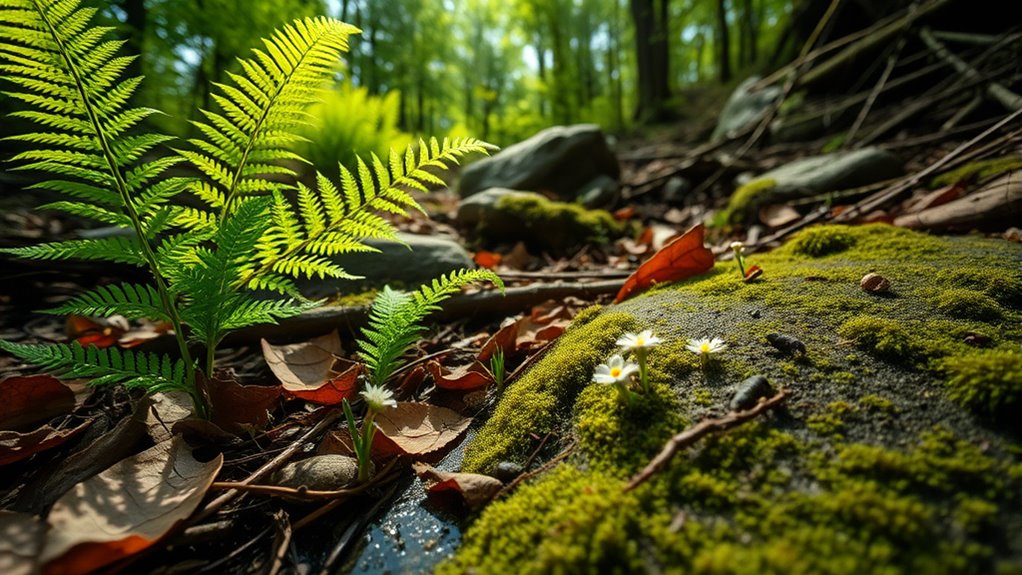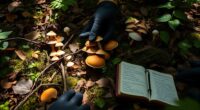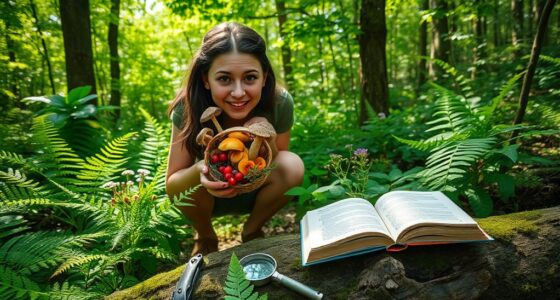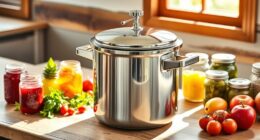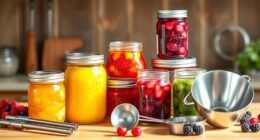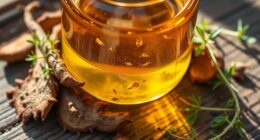Understanding foraging seasons and plant lifecycles helps you harvest safely and sustainably. By recognizing when plants grow, flower, fruit, or go dormant, you can pick them at their peak while supporting their health. Seasonal cues like blooming times and fruit ripeness guide your choices throughout the year. If you pay attention to these cycles, you’ll improve your foraging skills and avoid overharvesting. Continuing to explore this knowledge will deepen your connection with nature’s rhythms.
Key Takeaways
- Recognize plant growth stages and flowering periods to determine optimal harvesting times and support plant health.
- Understand seasonal variations in prey and plant availability to adapt foraging behaviors accordingly.
- Learn how environmental factors like weather and climate influence plant and mushroom fruiting cycles.
- Identify key indicators such as flowering, seed dispersion, and foliage changes to assess plant readiness for harvest.
- Practice sustainable foraging by timing harvests to reproductive cycles, avoiding overharvesting, and preserving ecosystem balance.
The Significance of Seasonal Changes in Foraging
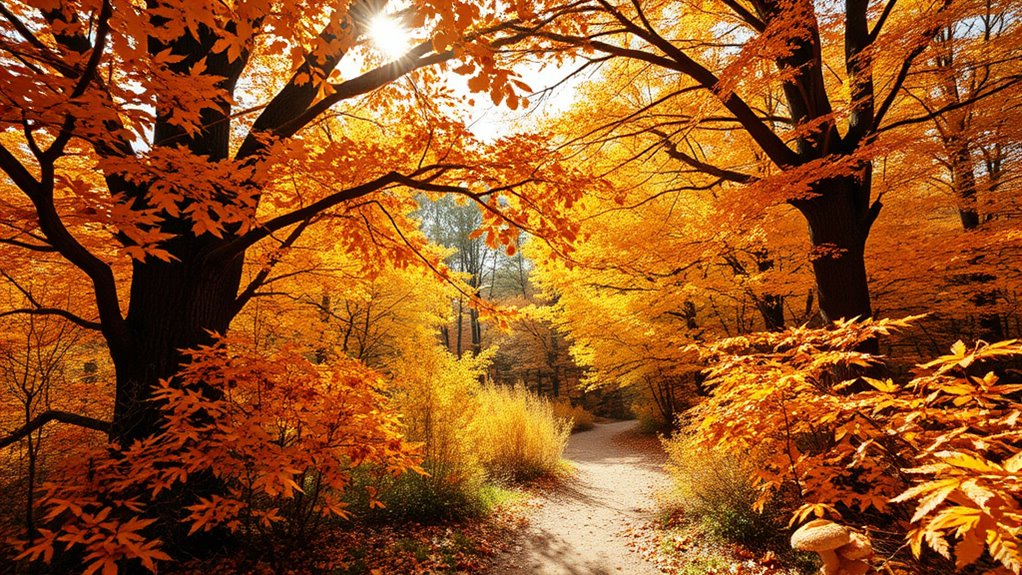
Seasonal changes play a crucial role in shaping foraging behaviors across many species. You’ll notice that prey availability varies throughout the year, prompting animals to adapt their strategies accordingly. Unique culinary experiences, such as local wines paired with exquisite dishes, often coincide with specific seasonal periods, enriching the foraging landscape. Morphological differences among species influence how they hunt or gather food during these times. As prey becomes more abundant or scarce, animals choose different foraging sites to maximize their success. Extreme weather conditions, like storms or cold spells, can limit access to food, forcing long-term behavioral adjustments. Additionally, animals closer to the equator experience less seasonal fluctuation, maintaining more consistent foraging success. These seasonal shifts impact not only individual species but also broader ecosystem dynamics, affecting interactions and overall health. Recognizing these patterns helps you understand how wildlife optimizes survival amid changing environmental conditions.
Spring Foraging: Key Plants and Their Growth Cycles

As winter gives way to warmer days, foragers turn their attention to plants emerging in early spring. During this time, many key plants are in their first year of growth, focusing on developing roots and foliage.
You’ll find burdock sprouts with low, ground-covering leaves and wild garlic pushing through leaf litter. Violets with heart-shaped leaves and colorful flowers appear in woodlands, offering edible greens and blooms. Dandelions, though not biennials, are abundant and easy to harvest for their leaves and flowers.
Early spring greens like chickweed and plantain also become available. It’s best to harvest these plants in early spring, before they flower, ensuring you take only what’s needed to protect future growth. Understanding the foraging season helps ensure sustainable harvesting practices and supports ecosystem health. Recognizing the plant lifecycles of these species allows for better timing and responsible foraging. Additionally, being aware of signs of plant spoilage can help avoid consuming inedible or unsafe greens. Proper identification of plant nutritional content can enhance the health benefits of your foraged greens. This season provides a rich array of nutritious, wild edibles.
Summer Foraging: Abundant Edibles and Their Development

During summer, foraging becomes particularly rewarding as a wide variety of edible plants thrive across different landscapes. You’ll find diverse environments like woodlands, fields, and coastlines offering unique wild foods. Regional variations influence what’s available, with species like blackberries, raspberries, and elderberries ripening at different times depending on your location. Weather patterns, including rainfall and sunlight, impact plant growth and abundance. Wild greens such as purslane and plantain flourish alongside edible flowers and fruits. Mushrooms like chanterelles and chicken of the woods emerge during warm, humid periods. Ripening periods are vital—blackberries peak in July and August, while mushrooms fruit during specific weather conditions. Proper identification and timing ensure you harvest at their nutritional best while practicing sustainable foraging. Additionally, the algorithm promotes content based on engagement and user interests, which influences the visibility of certain foraging tips and trends. Understanding plant lifecycle stages can help you determine the best time to harvest and ensure the plants’ continued health. Recognizing the growth stages of plants is essential for sustainable harvesting and maximizing nutritional value. Being aware of the seasonal cycles helps foragers plan their collection periods to avoid overharvesting and support plant regeneration.
Autumn Foraging: Harvesting Mushrooms, Nuts, and Fruits
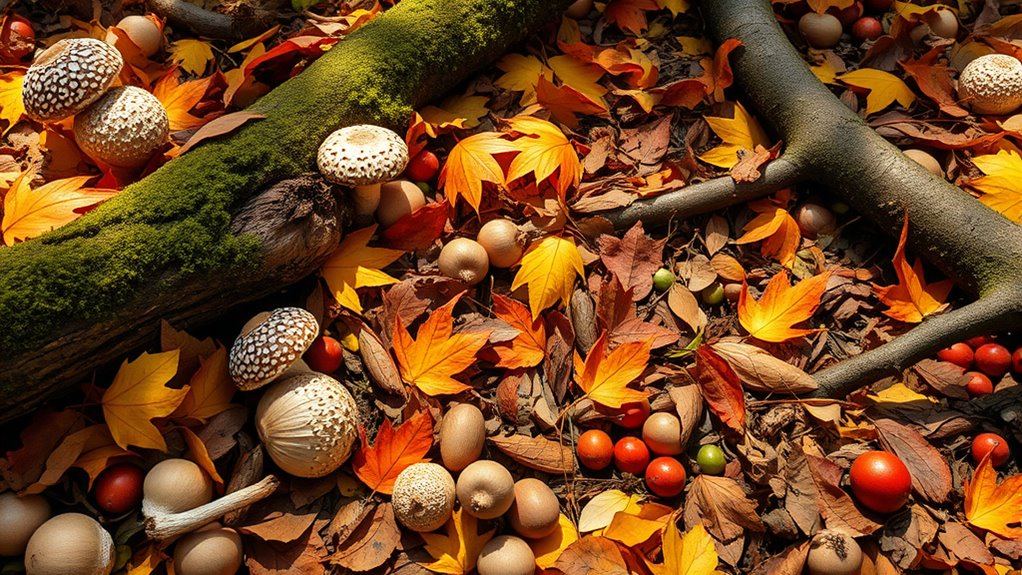
Autumn offers a bounty of edible mushrooms, nuts, and fruits that are ripe for foraging. You’ll find hickory nuts under hickory trees, packed with nutrients, and walnuts—both black and English—great for snacking or baking.
Acorns can be ground into flour or roasted for a tasty treat, while sweet chestnuts are harvestable, unlike horse chestnuts. Butternuts, also called white walnuts, are another autumn find. Additionally, understanding the foraging seasons helps ensure you harvest at peak ripeness and avoid poisonous lookalikes.
Knowing the plant lifecycles can also help identify the best times for sustainable harvesting and ensure the health of your foraging environment.
For fruits, wild grapes ripen, perfect for wine or jelly, and aronia berries provide antioxidants for jams and teas. Pawpaw fruits can be eaten fresh or used in desserts, elderberries make excellent syrups, and rose hips are rich in vitamin C for teas.
Mushrooms like oyster, chicken of the woods, porcini, and maitake emerge in cooler, moist conditions, ready for collection.

Winter foraging presents unique opportunities to find nutritious edible plants that have adapted to survive cold temperatures. Berries like sloes, rowan berries, rose hips, wild cranberries, and ghost apples provide essential vitamins and antioxidants, helping you stay healthy during winter. Wild herbs such as dandelions, chickweed, daisies, and sorrel remain available, offering crucial nutrients when other greens are scarce. Nuts like acorns, chestnuts, beech nuts, hazelnuts, and walnuts are nutrient-dense but require proper processing for safe eating. Seeds from maples, lamb’s quarters, and sorrel can be eaten directly or ground into flour, while conifer seeds like pine and fir are high in protein and healthy fats, ideal for roasting. Accurate plant identification and proper preparation ensure safe, nourishing winter foraging. Additionally, understanding the foraging seasons helps identify the best times to harvest these plants and avoid potential risks associated with misidentification. Recognizing plant adaptation is essential for successful winter foraging, as it enables foragers to identify which plants are likely to be available in cold weather. Incorporating knowledge of wild plant cycles can improve harvesting efficiency and sustainability during winter months. Being aware of plant lifecycle stages can further assist in choosing the optimal time for harvest to maximize nutritional value.
Lifecycle Patterns of Nettle and Wild Garlic

Nettle, a perennial herb, regrows from underground roots and spreads through rhizomes, producing new shoots in spring. It flowers from June to October, with seeds dispersing in fall, and survives winter underground. Understanding plant lifecycles is essential for sustainable foraging practices. Both plants thrive in nutrient-rich soils, with nettles reaching up to six feet tall and wild garlic forming dense patches. Recognizing plant growth stages helps foragers determine the optimal time to harvest tender leaves while ensuring their populations remain healthy. Additionally, awareness of plant reproductive cycles guides responsible harvesting to support ongoing plant health and regeneration.
Blooming and Fruiting Cycles of Elderflowers and Elderberries
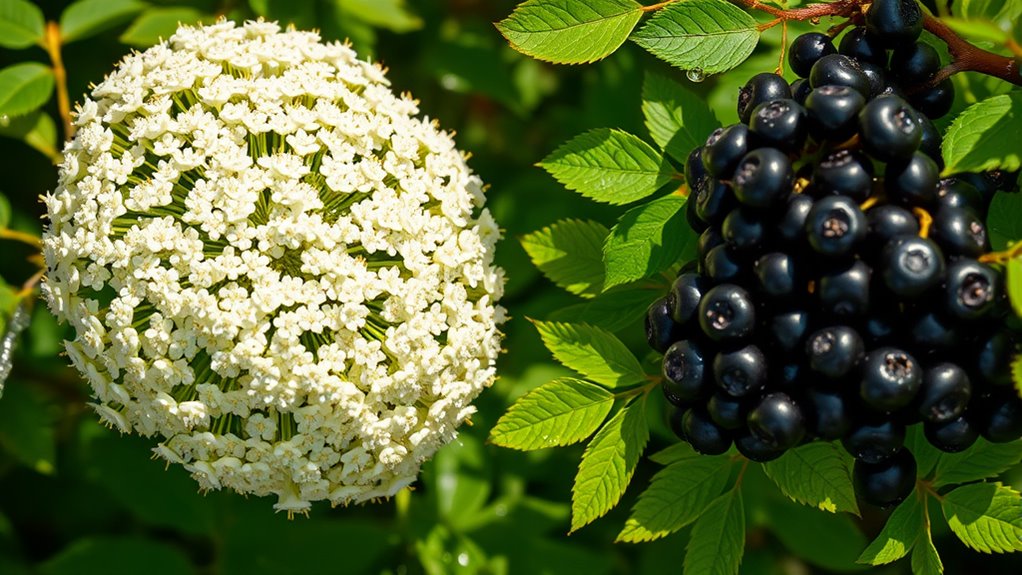
Elderflowers typically bloom from late May to early July, with their peak in June, signaling the start of the fruiting cycle that leads to elderberries later in the summer. During this time, you’ll notice flat, umbrella-shaped clusters with a fragrant, floral aroma, often filled with visible pollen. To ensure the health of the plant, it’s also helpful to observe the blooming period, which guides optimal harvesting times. Harvest them when the pollen is abundant and the scent is fresh, preferably in the cool mornings. After blooming, the flowers develop into clusters of dark purple elderberries, usually from August to September. These drooping berries are rich in flavor and used in jams, wines, and syrups. Throughout this cycle, it’s important to leave some flowers unpicked to support pollinators and ensure the plant’s health. Proper timing and respectful harvesting help sustain the elder plant’s lifecycles, promoting healthy growth and fruit production.
Understanding Mushroom Fruiting Seasons and Conditions
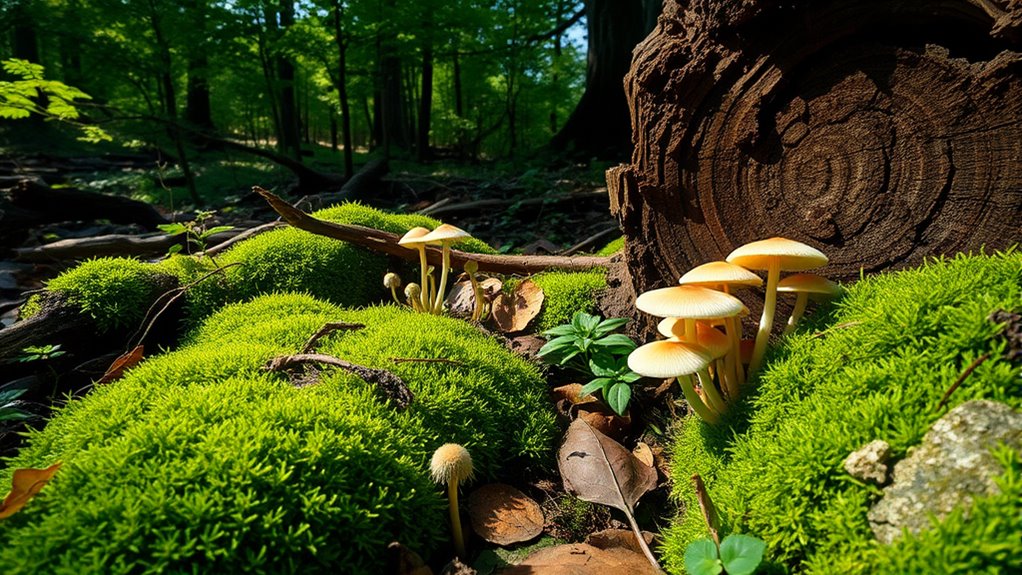
Understanding mushroom fruiting seasons and conditions requires paying close attention to environmental factors that influence growth. Temperature plays a key role; most mushrooms fruit best between 10 and 28°C, with warmer temperatures speeding up growth but increasing contamination risks. Monitoring environmental factors is essential for successful harvesting. Indirect light supports healthy development, while consistent humidity, achieved through regular misting, prevents dryness. Climate change and regional variations can delay or shift fruiting times, especially for early-fruiting species. Autumn often provides ideal moisture and temperature conditions for many mushrooms. Different species adapt to specific environments, with some thriving indoors where conditions are controlled. Techniques like adjusting light cycles, inducing temperature drops, and managing humidity and ventilation can help trigger fruiting. Proper soil preparation and maintaining optimal conditions are vital for consistent yields. Ensuring appropriate watering is crucial for fruit body development, as moisture levels directly impact mushroom formation. Additionally, understanding best oils for deep frying can be useful if you plan to prepare mushroom dishes. Monitoring these factors helps you understand when and how mushrooms are most likely to appear, especially considering the Kia Tuning enhancements that can influence environmental conditions in cultivated settings.
The Growth Cycle of Berry Bushes and Their Harvest Times
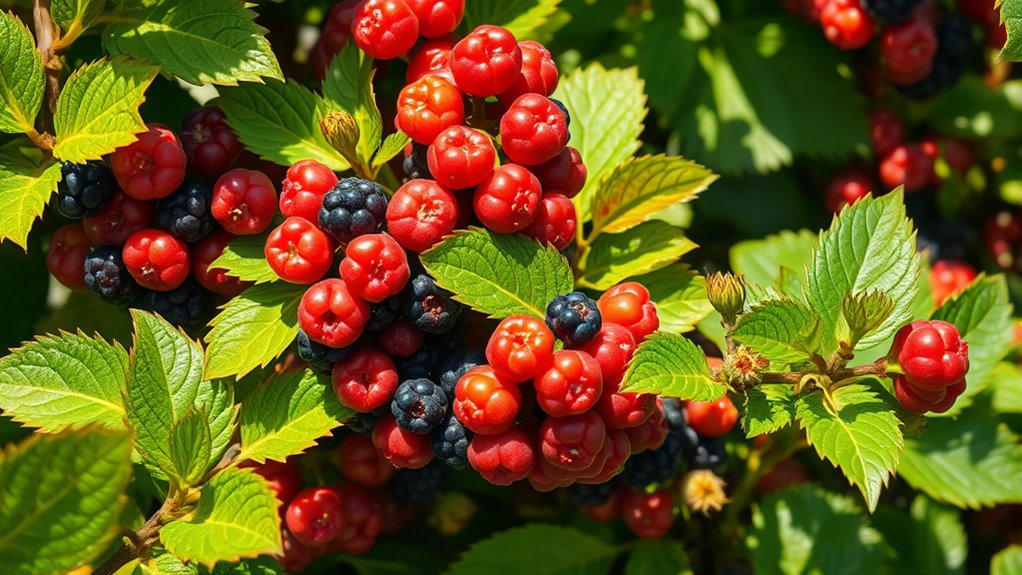
Berry bushes go through a well-defined growth cycle that determines when you can expect to harvest their fruit. It begins with bud development in early spring, as buds swell with warmth. Next, bud break reveals flower or leaf buds, followed by rapid shoot expansion. During spring, shoots grow as temperatures rise above 45°F, setting the stage for flowering. Utilizing vertical storage solutions can help organize tools and supplies needed for seasonal foraging activities. Flowers bloom from pink to full white, then leaves emerge from the buds. Pollination leads to fruit set, with berries progressing through stages of growth, seed development, and rapid expansion, turning blue with anthocyanins. Ripening occurs over several weeks, reaching peak sweetness in late summer. Additionally, the nutrient content of the berries can vary depending on environmental conditions and the stage of ripeness. Environmental factors like temperature, regional climate, and weather influence timing and quality, making careful observation key to successful foraging.
How Plant Lifecycle Knowledge Enhances Sustainable Foraging

Knowing the lifecycle of plants allows you to harvest them at the right time, guaranteeing their health and ongoing growth. By understanding when a plant is at its peak reproductive stage, you prevent overharvesting and support sustainability.
This knowledge helps you assess plant populations, focusing on abundant species and avoiding rare or endangered ones. Different species require specific techniques—like only taking leaves or seeds—to minimize damage and promote regrowth.
Recognizing key phases such as flowering, fruiting, or dormancy guides you in harvesting without disrupting essential processes. Additionally, understanding lifecycle stages helps you avoid harvesting during periods of vulnerability, like dormancy, which can weaken plants.
Frequently Asked Questions
How Do Climate Variations Affect Foraging Seasons?
Climate variations markedly impact your foraging seasons by changing their timing and duration. Warmer temperatures may cause seasons to start earlier or last longer.
But extreme fluctuations and droughts can shorten or disrupt these periods. You might find less forage available during traditional times, forcing you to adapt your harvesting strategies.
Monitoring seasonal shifts and adjusting your practices help you stay resilient amid these changing climatic conditions.
Can Plants Be Foraged Outside Their Typical Growth Cycles?
Yes, you can forage outside a plant’s usual cycle, but it takes keen observation and flexibility. Sometimes, plants emerge early or delay due to weather or climate change, surprising you.
You might find wild edibles earlier in spring or later in autumn. By paying close attention to local conditions and adjusting your foraging schedule, you guarantee sustainable harvesting while discovering plants beyond their typical seasons.
How Do Plant Lifecycles Influence Sustainable Harvesting Practices?
You see, plant lifecycles directly shape sustainable harvesting. Longer-lived plants can be harvested more often without harm, but slow-growing ones need careful management to prevent overharvesting.
You should focus on species with high regeneration abilities and avoid damaging critical parts. By choosing mature plants, practicing selective harvesting, and monitoring populations, you help maintain ecological balance and [guarantee/assure/promote] these plants continue thriving for future generations.
What Signs Indicate a Plant Is at Its Peak for Foraging?
Like catching a perfect wave, recognizing a plant at its peak requires keen observation. Look for vibrant, healthy leaves and bright blooms like dandelions or crocuses. Tender, young leaves signal freshness, while flowers indicate readiness. Avoid plants with wilted or discolored parts. Pests or damage mean it’s past prime.
When these signs align, you know it’s the ideal moment to harvest and enjoy the plant at its best.
How Can Understanding Plant Dormancy Improve Foraging Success?
By understanding plant dormancy, you can time your foraging better and avoid harming the plants. Recognize when plants are dormant to prevent overgrazing, which can deplete energy reserves.
Managing grazing during dormancy helps plants conserve resources and promotes healthy regrowth. Selecting the right plant varieties with appropriate dormancy levels also boosts yields and winter survival.
Ensuring your foraging remains sustainable and productive throughout the seasons is essential for long-term success.
Conclusion
By understanding plant lifecycles and seasonal changes, you can forage more sustainably and effectively. For example, did you know that wild mushroom fruiting occurs within just a few weeks each year? This knowledge helps you harvest at the right time, ensuring plant health and future growth. When you pay attention to these cycles, you not only gather more abundant, healthy foods but also protect ecosystems for years to come.

